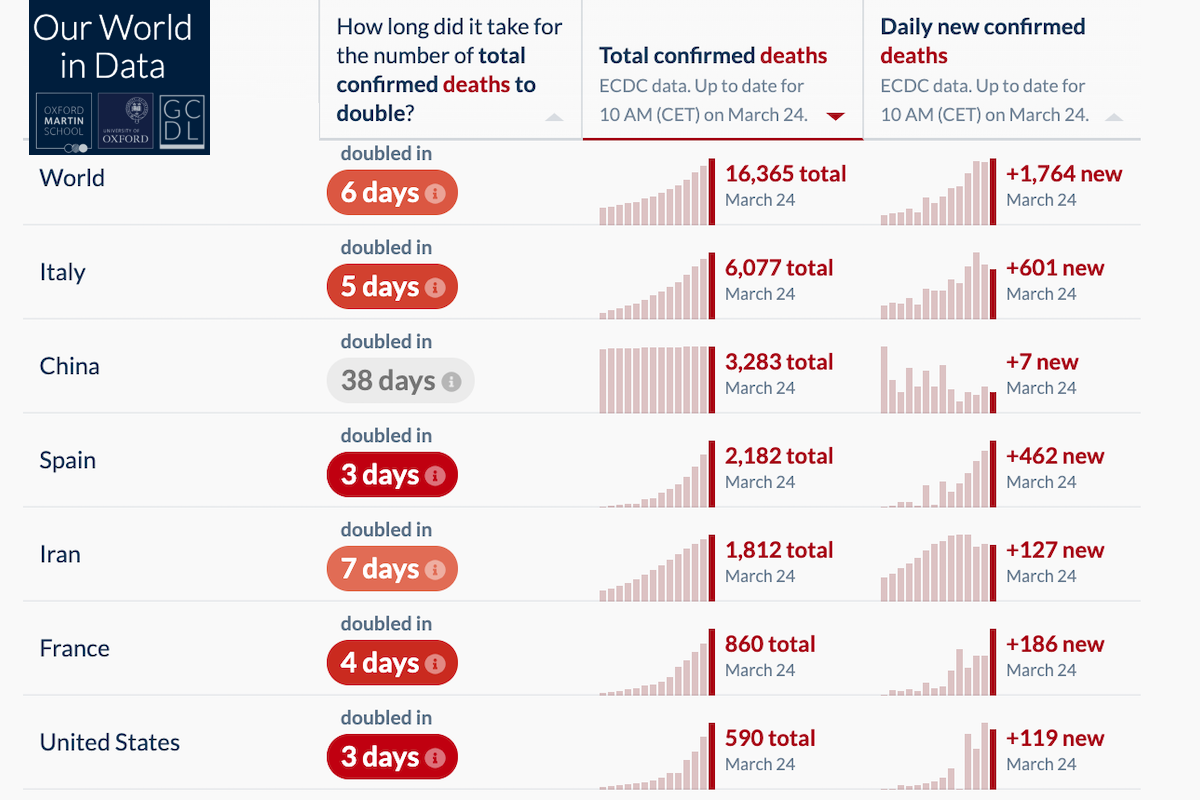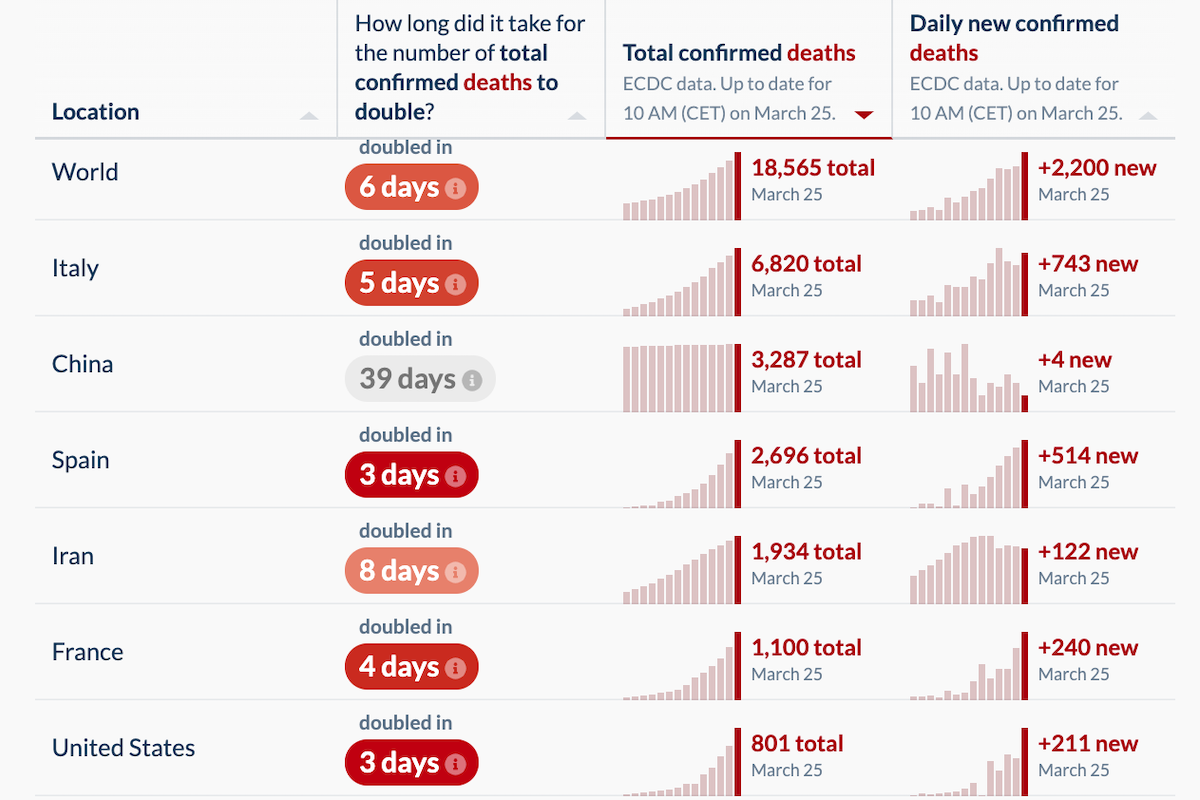COVID-19 Updates
COVID-19 Science Update for March 24th: Counting Cases and Deaths
The analysis here is complicated, because a massive testing regime doesn’t seem to be a necessary component of COVID-19 suppression.

The latest global data for COVID-19—updated with reports received on March 24th, 2020—have been published at Our World in Data. Here are some of the numbers and trends that I believe deserve special attention, as well as a brief report on notable developments and analyses. Since March 21st, these updates have been published at Quillette in our section marked COVID-19 UPDATES. Please report needed corrections or suggestions to [email protected].
There were 1,764 new deaths reported globally over the last day. This represents an increase from the previous day’s jump, which was 1,660, and Sunday’s reported jump, which was 1,690. France had its deadliest day yet, with 186 deaths. The United States had 119 deaths, down from 131. Crucially, Italy had its second day in a row of declining death count—601 versus Monday’s 649 and Sunday’s 795. (Italy also had its second straight day of decline in new cases reported: 4,789, down from 5,560 and 6,557 on Monday and Sunday respectively.) Spain’s daily tally jumped to 462, up from 394 on Monday. If these trends continue, it is possible that Spain could have more daily deaths than Italy by the end of the week.
Denmark reported 11 new deaths, representing almost a doubling of total deaths in that country. This is a predictable delayed effect given that Denmark’s initial surge of freshly reported cases began two weeks ago. A similar pattern of delay-then-death has been playing out, at various scales, in Sweden, Austria, the Netherlands, Belgium, Germany, Portugal, the UK, and Brazil. On a much smaller scale: Greece had a surge of cases in mid-March, and now is experiencing its first steady stream of fatalities this week. Typically, this cycle time in national statistics seems to be about 10 days.
Unfortunately, this pattern suggests that several other countries—including my own, Canada—are set for a continuing uptick in new deaths. If Canada continues its current baseline of about 200 new cases per day, which it has maintained for the last week, it also is likely to witness at least several deaths every day. Until now, each Canadian COVID-19 death has been the subject of media headlines. But that will change as the deaths increase, the fear factor declines, the phenomenon becomes more familiar, and we begin to grapple with the disease not as a one-off crisis, but as an ongoing public-health issue that needs to be actively managed. Canada reported six new deaths yesterday (about the same number of Canadians who die every day in traffic accidents), bringing its total to 23.
All of this said, one cannot simply graph a nation’s new-case data, and then assume that a graph of new deaths will simply be a delayed but congruent data shadow. That’s because deaths are all too real, while new-case data is an artifact of testing.
In China and some of the other countries that first got hit with the COVID-19 pandemic, deaths were massively overrepresented in the initial days of the crisis—since the only cases that anyone knew about were the critical-condition patients who often died just a few days after presenting at hospital. It is only in recent weeks that countries without massive outbreaks began to make testing widely available. As that trend continues, the longitudinal relationship between new cases and new deaths should become more predictable.
Let’s look at today’s data in regard to new confirmed COVID-19 cases. After a decline from Sunday’s to Monday’s newly reported cases (34,047 down to 33,028), we saw a big jump today, with 39,738 cases. This was driven by massive increases in France (3,838 new cases, compared to 1,559 new cases reported the previous day), Germany (4,438 versus 3,311 previously), Spain (4,517 versus 3,646 on Monday) and the United States (11,236 new cases versus 8,459 on Monday).
It’s hard to know what to make of these jumps, however, since—and this is a point I need to repeat in every daily update—more widespread testing (such as is being rolled out in virtually every affected country) is always going to be associated with a surge in newly discovered mild (or even asymptomatic) cases that otherwise might have come and gone without public notice. The identification of such mild cases will mean that (1) the apparent case fatality rate will go down; and (2) vulnerable people who are old or medically frail will gain more protection because infected persons can self-isolate.
The analysis here is complicated, because a massive testing regime doesn’t seem to be a necessary component of COVID-19 suppression. Denmark and Canada, for instance, seem to be managing decently (though not spectacularly) without such a comprehensive policy. But the countries that have scored the most decisive successes in quashing a crisis that has already started—South Korea and China—generally tested the population vigorously.
Speaking of South Korea: On March 20th, Reuters posted an excellent data-visualization feature called The Korean Clusters: How Coronavirus cases exploded in South Korean churches and hospitals. The key role of “Patient 31” in infecting (directly or indirectly) literally thousands of South Koreans already is well-known, in part thanks to a widely circulated New York Times feature from early March. But Reuters’ graphics designers have found a creative way to illustrate how Patient 31’s controversial Christian congregation, the Shincheonji Church, became the nucleus for a cluster of COVID-19 patients that includes—this is almost beyond belief—at least 60 percent of all known South Korean cases.

The feature also helps explain how the pandemic’s South Korean epicenter came to be located in the south-eastern city of Daegu, which has witnessed more than 20 times more cases than the much more populous capital of Seoul. When it comes to the missed opportunities many countries had to abate the 2020 COVID-19 crisis, this one sentence jumps out: “On February 15, doctors at the hospital said they first suggested she be tested for coronavirus, as she had a high fever. Instead, [Patient 31] went to a buffet lunch with a friend at a hotel.” (The next day, Patient 31 went to church. Thousands of her fellow congregants are now sick.)
As noted above, and in previous updates, South Korea represents the state of the art in COVID-19 testing and infection-network forensics (which is why Reuters had such detailed data to work with in preparing The Korean Clusters). At the other end of the spectrum is Iran, which has been accused of disguising the true extent of its COVID-19 epidemic for weeks. In a recent Quillette column, Shay Khatiri of Johns Hopkins University’s Paul H. Nitze School of Advanced International Studies laid out the possible links between repressive Iranian policies and the rapid spread of the disease within Iran’s borders. And in a recent article published by the Committee to Protect Journalists (CPJ), their Middle East and North Africa staff have made a persuasive case that Iran has not only been attempting to minimize its COVID-19 casualty numbers, but that it is seeking to intimidate journalists who tell the truth. One Kurdish journalist quoted tells the CPJ that even health-care workers have been strong-armed: “It is possible to get the real numbers in smaller towns but in bigger cities like Tehran or Isfahan, doctors and hospitals were ordered to not list the coronavirus as cause of death.”
Even in countries that make good-faith efforts to provide the world with the most accurate data, the question of what counts as a confirmed COVID-19 fatality can be difficult to answer. In Italy, for instance, an analysis of the first 105 patients who’d died showed that about two-thirds had at least three pre-existing health conditions, the most common being hypertension, ischemic heart disease, and diabetes mellitus. In the case of acute comorbidities that affect respiratory function, it can be unclear whether a patient can be said to have died of COVID-19, or the pre-existing condition, or both. (Indeed, one of the reasons why the COVID-19 death rate has been so high in Italy is that their patients have been both especially sick and especially old. As one media report noted, “a study in the Journal of the American Medical Association this week found that almost 40% of infections and 87% of deaths in [Italy] have been in patients aged over 70… The majority of this age group are likely to need critical hospital care—including 80% of 80-somethings.”)
According to Professor Walter Ricciardi, scientific adviser to Italy’s health minister, “The way in which we code deaths in our country is very generous in the sense that all the people who die in hospitals with the coronavirus are deemed to be dying of the coronavirus. On re-evaluation by the National Institute of Health, only 12% of death certificates have shown a direct causality from coronavirus, while 88% of patients who have died have at least one pre-morbidity—many had two or three.” This has been interpreted by some to mean that 88 percent of the reported Italian COVID-19 data might be dubious or even invalid. But a more likely interpretation is that the presence of pre-existing conditions simply makes it difficult to apportion medical causality absent the sort of invasive and time-consuming case-by-case investigations that clearly lie beyond the scope of a medical system facing a once-in-a-generation crisis.
Finally, a dispatch from Sweden, which now marks the liberal end of the West’s lockdown continuum.
As with many European countries, Sweden started observing its first COVID-19 cases in late February and early March. The daily rate of new Swedish cases passed 100 on March 12th, and has mostly remained in the low 100’s ever since. The country has had 25 COVID-19 deaths. Statistically, it looks a lot like, say, Canada or Denmark. But unlike those countries—in fact, unlike pretty much every OECD country—schools, cafés and bars are still open in Sweden. As Bloomberg reports in an article headlined Swedes Try Laissez-Faire Model in Controversial Virus Response, “the Swedish approach raises questions about how socially distant we need to be to stay safe, given the devastating impact of shutting down an entire economy.”
In effect, Sweden is operating a massive control group for the OECD, as part of an unintended mass-participation experiment aimed at determining how much we have to ramp down public life in order to fight COVID-19. It will be important to watch Sweden’s numbers in coming days: If the Swedes succeed in controlling their outbreak while keeping their retail economy going, that may help policy-makers in other countries refine their approach once we eventually start returning our lives to a (more) normal footing in coming weeks and months.
According to one Nobel laureate, at least, that return to normalcy may come sooner that you think. “What we need is to control the panic,” says Stanford biophysicist Michael Levitt, who has been analyzing the COVID-19 data since January, and was among the first to publicly note the positive turn in China’s data. Overall, “we’re going to be fine.” But he also cautions that his analysis is based on the expectation that we continue to practice common-sense social distancing. As he told the Los Angeles Times, “This is not the time to go out drinking with your buddies.”
This remains good advice, even if your horoscope says otherwise:
An hour in the life of this public editor: Here's a pandemic-related issue I did not anticipate: @TorontoStar horoscope column includes "advice" to party with friends. Several readers express concern.
— Kathy English (@kathyenglish) March 23, 2020






